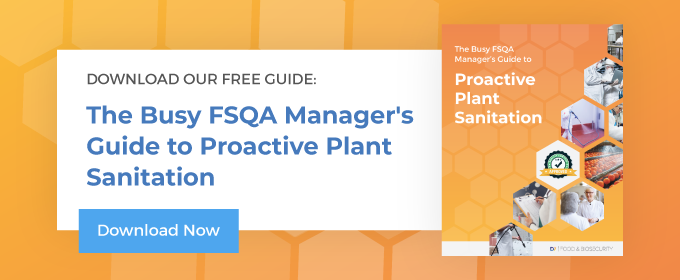Daily sanitation is essential for keeping unwanted bacteria at bay in a food processing environment, but it’s also important to do periodic deep cleans. The intent of daily sanitation is to consistently keep bacteria at safe levels and to prevent the formation of biofilms on surfaces. By regularly treating work surfaces, equipment, walls, ceilings, and floors, bacteria are not able to rapidly multiply, potentially causing an outbreak.
However, daily sanitation does not always allow time for reaching the deepest nooks and crannies or the surfaces that are difficult to access. If left untreated, these areas can be havens for bacteria to grow and spread. This is why regularly performing a deep clean is so important for maintaining a food processing facility.
What Is a Deep Clean?
A deep clean is a periodic cleaning event in which sanitizing is taken to another level. Equipment may be fully disassembled to sanitize parts that are not otherwise accessible. CIP systems may be flushed with a sanitizing chemical. Tables and equipment may be moved to access the spaces in between, behind, and underneath, where daily cleaning doesn’t address. Deep cleaning might also include a comprehensive cleaning of the drain and HVAC system to prevent the growth of bacteria in hidden spaces.
Deep cleaning can be done in response to tests that show the presence of bacteria even after daily sanitizing, or if a persistent biofilm has been detected. The specific steps required will depend on the facility and the equipment in it, but the goal is to treat every surface in a facility where bacteria has the potential to grow. The chemicals used during a deep clean may be stronger or different from those used daily, especially if a particular pathogen has been problematic.
Why Soaking Is an Important Step in a Deep Clean
Although daily sanitation typically involves spraying liquid or foam onto surfaces, deep cleaning often goes a step further to include soaking. Soaking not only ensures that the sanitizing chemical has sufficient time to do its work, but also allows it to reach every surface and penetrate every access point.
Soaking can be used to clean personal protective equipment and tools, before mopping floors, for sanitizing tubs and drains, and for treating utensils. It is also a good way to sanitize equipment parts, especially those with small openings or other features that make them difficult to clean. Of course, the chemical you choose for soaking is important. Choosing a product like D7, which does not require mechanical scrubbing to remove bacteria or biofilm, will ensure that soaking is an effective way to sanitize. The long-lasting foam provides a way to soak or douse in place because it creates the same all-encompassing contact time that submersion does. Items can also be soaked in the traditional manner with D7 liquid, as long as there is a receptacle large enough for complete submersion.
Use Deep Cleaning for Prevention
A deep clean is often performed in response to an outbreak, but it can also be used as a preventive tool. Scheduling deep cleans on a regular basis or between shifts that process different food products can help prevent outbreaks and cross-contamination from occurring in the first place. When employees ask, “What is a deep clean?,” be prepared with training content that will help them understand the importance of doing it on a regular basis and exactly how to do it.
Daily sanitation and deep cleans are just two of the best practices that will help keep your facility safe from contamination. For more helpful tips about how to prevent outbreaks in your facility through daily sanitation and deep cleans, download and read the The Busy FSQA Manager’s Guide to Proactive Plan Sanitation.


